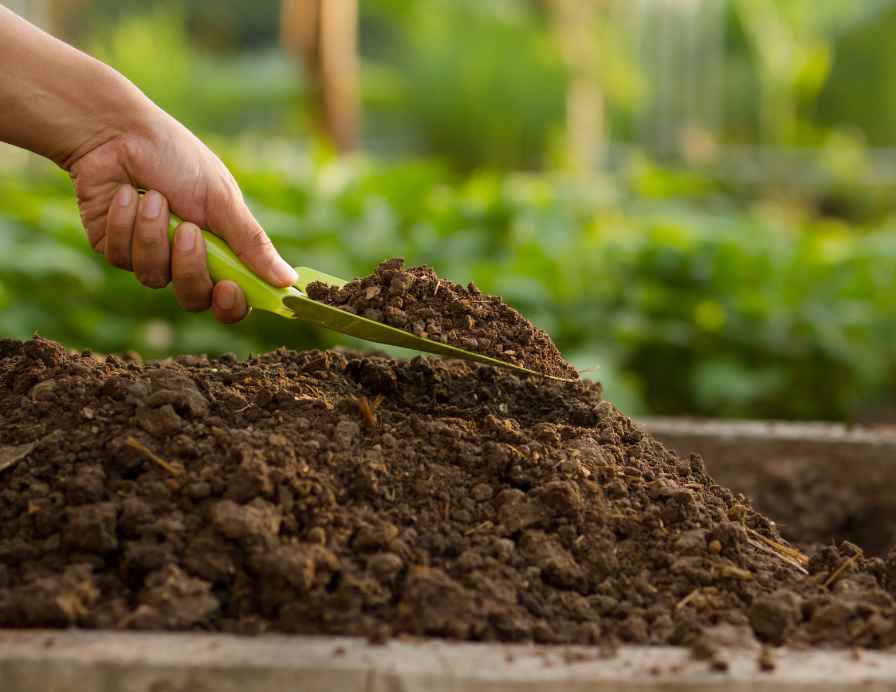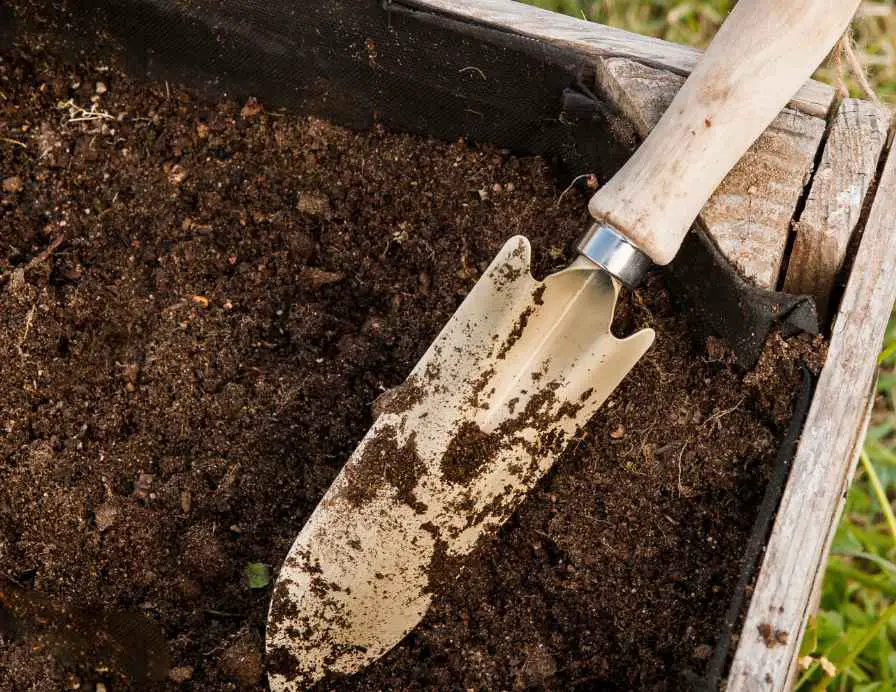While going gardening, the one main question of input is about soil. especially when it is to be used in garden beds. What soil is good for garden beds? How to make that soil, and how to save that soil? well, we are going to tell you about that.

Growing Plants in Garden Beds
Garden beds are a popular and effective way to grow plants, whether you have a small backyard or a larger outdoor space. These raised areas of soil provide several advantages for plant growth and cultivation. One of the primary benefits of garden beds is improved drainage.
The elevated construction prevents waterlogging and encourages healthier root systems by making it easier for excess water to drain away. Additionally, garden beds offer better soil quality control.
You can fill them with high-quality soil, rich in organic matter, and tailor it to suit the specific needs of your plants. This allows for optimal nutrient availability, root development, and overall plant health.
Another advantage of garden beds is that they provide a defined space for gardening. By confining your plants to specific beds, you can better manage their growth and prevent them from encroaching on other areas of your garden.
This helps with weed control and makes maintenance tasks, such as watering, fertilizing, and harvesting, more manageable. Moreover, garden beds offer an opportunity for crop rotation, which is beneficial for long-term soil health.
Tips for Better Growth in Garden Beds
By rotating your crops each season, you can reduce the risk of pests and diseases building up in the soil and optimize nutrient utilization. When planning your garden beds, consider factors such as sunlight exposure, spacing between plants, and accessibility for maintenance.
You can create garden beds using various materials, including wood, stone, concrete blocks, or even repurposed materials like old tires or wine barrels. The size and shape of your beds depend on the available space and your gardening preferences.
Remember to leave enough room between beds for easy maneuverability and to provide pathways for walking and working in the garden. With proper planning and care, garden beds can provide a productive and aesthetically pleasing space for growing a wide range of plants, from vegetables and herbs to flowers and ornamentals.
What Soil is Good for Garden Beds?

Well. The garden soil available in your garden is not good for the garden beds. You can use it, but ideally, it cannot be used as garden beds are specific in nature, so the soil for them is also specifically made.
Loamy soil is considered ideal for garden beds due to its specific qualities, which contribute to healthy plant growth. Here are some characteristics and qualities of loamy soil:
Balance of Particle Sizes
Loamy soil has a balanced composition of different particle sizes, including sand, silt, and clay. This balanced mixture allows for good water drainage, preventing waterlogging, while also retaining moisture for plant roots to access. It strikes a harmonious balance between drainage and water-holding capacity.
Good Drainage
The presence of sand particles in loamy soil promotes excellent drainage. Excess water can easily move through the soil, preventing water accumulation that can drown plant roots and lead to root rot. Adequate drainage also helps prevent nutrient leaching and reduces the risk of fungal diseases.
Moisture Retention
The silt and clay particles in loamy soil contribute to its ability to retain moisture. These smaller particles have better water-holding capacity, ensuring that plant roots have access to moisture during dry periods. This characteristic is particularly beneficial for plants in garden beds, as they can better withstand drought conditions.
Nutrient-Rich
Loamy soil often contains a good amount of organic matter, such as decomposed plant material, which enhances its nutrient content. This organic matter provides essential nutrients for plant growth and supports a healthy soil ecosystem.
The balanced composition of loamy soil also helps in retaining nutrients and making them available to plant roots.
Easy to Work with
The texture of loamy soil makes it easy to work with during gardening activities. It is neither too sandy nor too heavy with clay, allowing for proper root penetration and expansion. This makes it easier for plants to establish and access nutrients in the soil. It also facilitates cultivation tasks like planting, weeding, and harvesting.
Versatility
Loamy soil is versatile and suitable for a wide range of plants, including vegetables, flowers, herbs, and ornamentals. Its balanced composition and nutrient-rich nature provide a favorable environment for various plant types to thrive.
Overall, loamy soil’s qualities include a balanced mixture of sand, silt, and clay, good drainage, moisture retention, nutrient-rich composition, ease of working with it, and versatility. These attributes make it an excellent choice for garden beds, as it supports healthy plant growth and provides an optimal growing environment.
How to Make loamy soil for Garden Beds
To create loamy soil for your garden beds, you can improve the existing soil by adding amendments and adjusting its texture. Here’s a step-by-step process to make loamy soil:
Assess the Soil
Start by assessing the current soil in your garden beds. Determine its texture, drainage capacity, and nutrient content. This will help you understand what amendments are needed to achieve a loamy soil composition.
Amend with Organic Matter
Organic matter is a key component of loamy soil. Add generous amounts of compost, well-rotted manure, leaf mold, or other organic materials to the garden bed. Spread a layer of organic matter on top of the existing soil and incorporate it by digging or tilling to a depth of around 8 to 12 inches. This will help improve soil structure, water retention, and nutrient content.
Adjust Soil Texture
Loamy soil should have a balanced texture, so if your existing soil is too sandy or heavy with clay, you’ll need to adjust it. If the soil is too sandy, add silt or clay to improve its water-holding capacity. Incorporate these materials into the soil by digging or tilling. If the soil is heavy with clay, add sand, perlite, or vermiculite to improve drainage and aeration.
Check and Adjust the pH
Use a pH testing kit or send a sample to a facility that analyses soil to determine the pH of your soil. The pH range of 6 to 7 is ideal for the majority of plants.
Adjust the pH if necessary by adding lime to raise the pH of acidic soil or sulfur to lower the pH of alkaline soil. Follow the recommended application rates based on your soil test results.
Maintain Organic Matter
It’s important to continue adding organic matter to your garden beds regularly. This can be done by incorporating compost or other organic materials into the soil each year or seasonally. This ongoing addition of organic matter will continue to improve the soil structure and nutrient content, ensuring the long-term health of your garden beds.
Monitor and Adjust
Regularly monitor the condition of your garden bed soil. Observe how it drains, retains moisture, and supports plant growth. Make adjustments as needed by adding more organic matter, adjusting the pH, or making texture modifications to maintain the ideal loamy soil qualities.
In a nutshell, the loamy soil is good for the garden beds. You just have to prepare it, if it is not up to the mark. Also, do check for minor adjustments of PH, and other ingredients. Once prepared you are good to go with your garden beds.
FAQs
Can I use the garden bed soil in pots?
Yes, you can easily use the garden bed soil in the pots. If you have leftover soil from the beds, do use it. Just make sure it is not so tight so that it can allow the growth of roots in the pots.
Are potting soil and garden bed soil different?
Yes, these are different soils. Potting soil is simple soil for all of the plants in the pots and is also used as garden soil as well. While the garden bed soil is usually loamy soil mixed with different ingredients to match the requirements of plants in the beds.

